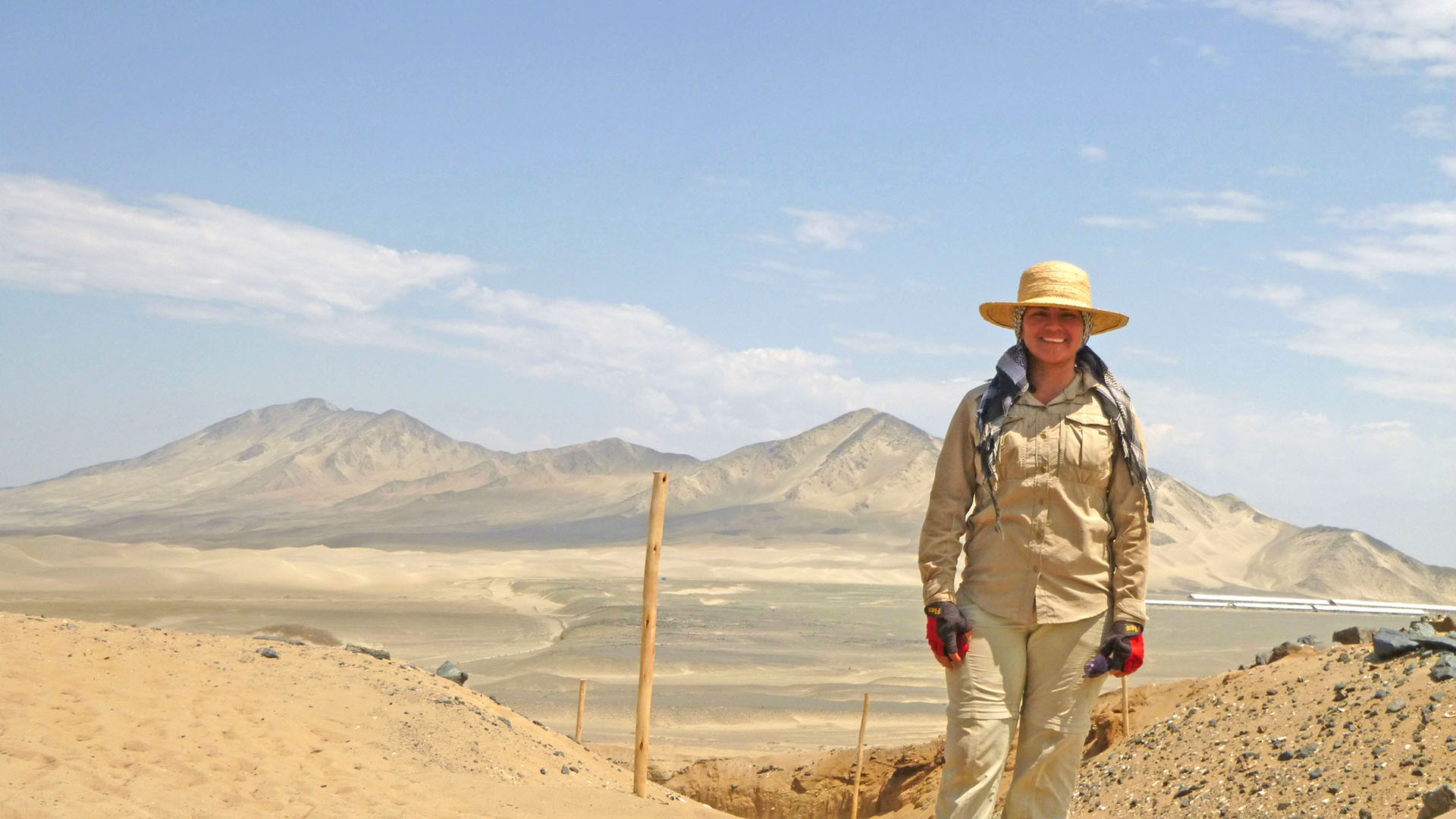
Uncovering Peru’s History
In the lower Chao Valley on the north coast of Peru, University of Maine graduate student Ana Cecilia Mauricio is uncovering history.
Mauricio defended her thesis this past May and is expected to graduate from the University of Maine with her Ph.D. in geoarcheology in August 2015. Her research focused on an archaeological preceramic period site called Los Morteros, located in Pampa de las Salinas — an area nestled between iconic Andean foothills to the east and south, the Pacific Ocean to the west and the Chao River to the north.
Geoarchaeology is a multidisciplinary approach that combines techniques and subject matter from a variety of Earth science fields to interpret archeological findings.
The site was originally thought to be a natural feature, resembling a dune common to the Peruvian terrain. At the start of her research project, Mauricio aimed to uncover what was once under the sand cover of the mound, and to understand how humans utilized the area.
Her research showed that the site holds one of the oldest manifestations of monumental buildings in the central Andes.
The site — 200 by 200 meters, with its highest point being 15 meters high — contains structures built with mud bricks, scientifically referred to as adobes. The use of adobes is an ancient architectural tradition found in the Andes.
The adobes Mauricio discovered in Los Morteros are the oldest reported mud bricks in the central Andes, making the site and region a potential origin for the use of such materials.
Growing up in Chimbote, Peru, Mauricio was inspired to be an archaeologist by the rich and ancient history of her homeland. She received her undergraduate degree in archaeology at Peru’s National University of Trujillo before arriving at UMaine in 2009.
“I have always worked in Peru, mostly on the central and north coast. It is a region where you can find all periods of prehistory and makes it possible to investigate all sorts of topics. The weather is perfect and the food is wonderful,” Mauricio said.
When she was looking into graduate programs, Mauricio was drawn to UMaine for the interdisciplinary opportunities. While in Orono, she enjoyed going to the gym, biking around campus and the beauty that came with the changing of the leaves.
“I chose this university because I wanted to develop environmental approaches in Peruvian archaeology,” she said. “I decided on the interdisciplinary master’s program in the Climate Change Institute because you learn about the climate and environment from different perspectives.”
She came to UMaine on a Fulbright and subsequently received the Waitt Grant of the National Geographic Society, and the Beca Andina de Investigacion from the French Institute for Andean Studies.
Among other accomplishments, she published her first book in June, which described a previous archaeological research project carried out in the Lima region. She hopes to have a second book published in September.
Mauricio and her team found the first phase of human occupation in Los Morteros was in the center and lowest part of the mound, where they discovered stone hearths containing small fish bones, charcoal and scallop shells. The calibrated dates for this occupation are from 5700 to 5400 BP.
The second phase of occupation was found at the northwest sector of the mound, where researchers uncovered a large room made of adobes with plastered walls, clay floors and internal architectural features.
The third phase of the occupation — and most recorded — was located near the top of the mound. The researchers discovered the remains of stone architecture, including a large room, a stone platform, stone hearths and clay floors.
A particular feature of this architecture is the presence of standing stone, which is a characteristic element of late preceramic sites. The feature is locally called huanca a quechua, a word from the ancient language of the the Andes.
Mauricio estimated the age of the mound to be at least 7,000 years BP. She used the rate of sand accumulation, which was 10 meters to 12 meters, between the level of stone hearth and the base of the mound to calculate the amount of time passed.
She is currently back in Peru and will soon be working as the research director for the archaeological site of Chan Chan — a UNESCO world heritage site — sponsored by the Peruvian government. She plans on continuing her research at Los Morteros.
Mauricio’s adviser while at UMaine was Daniel Sandweiss, a leader in Andean archaeology and environmental archaeology. Sandweiss is a professor in the Climate Change Institute and the Department of Anthropology, as well as cooperating professor in the School of Earth and Climate Sciences and the School of Policy and International Affairs.
Mauricio was a master’s student when she first became involved with the site at Morteros in 2010. That year, she helped a team of UMaine researchers, led by Sandweiss, complete a georadar survey of the site — a continuation of preliminary georadar work done in 2006. She then decided to focus her dissertation on what was found.
Among the survey team members was Alice Kelley, an assistant professor in the Climate Change Institute, who became one of Mauricio’s primary mentors throughout her research project and served on her dissertation committee.
“It’s very exciting to contribute to building the history of my country with my research,” Mauricio said. “I also like very much the fact that archaeology is a discipline where you have to learn about other scientific fields and work in interdisciplinary environments.”
Contact: Amanda Clark, 207.581.3721
